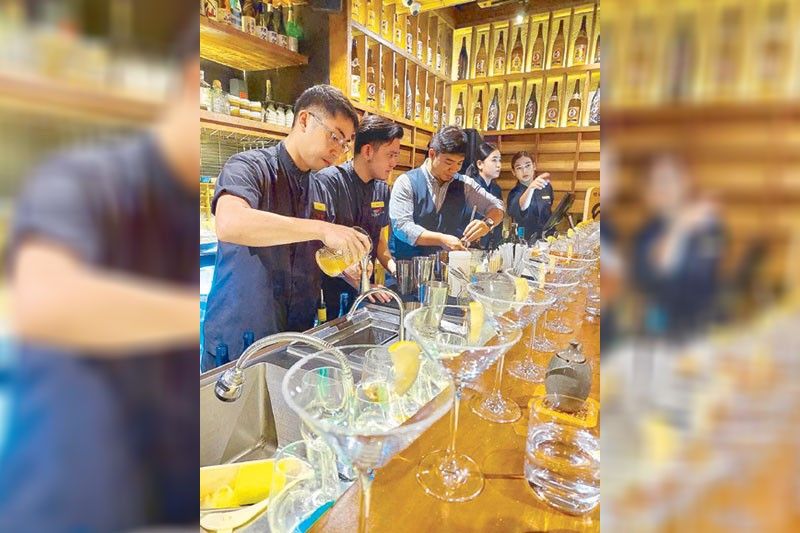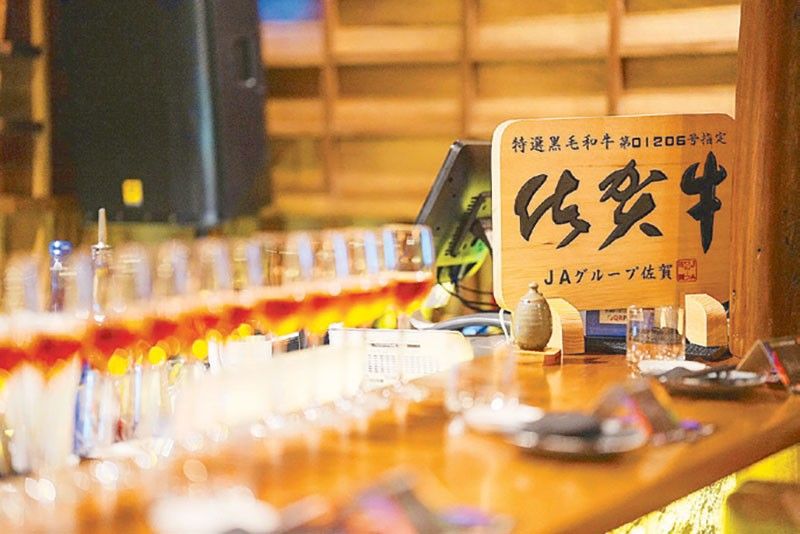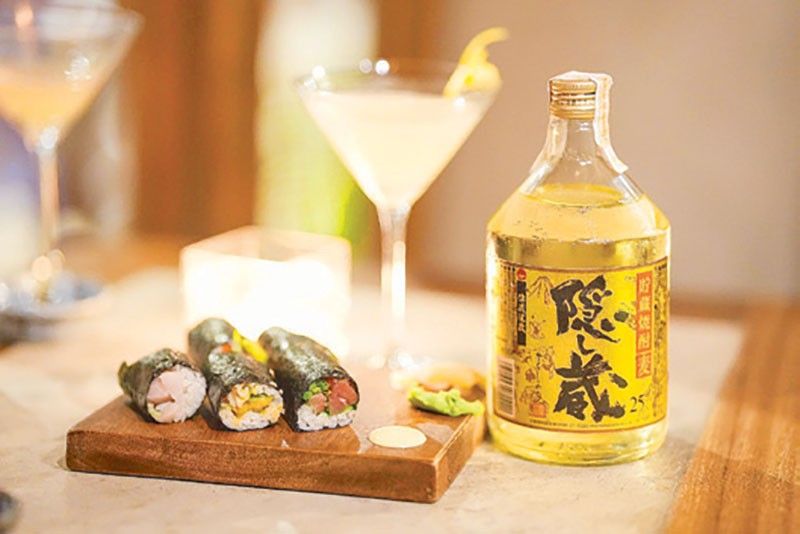Communing with Japanese spirits

Drinking Japanese spirits such as sake or, in this case, shochu, involves drinking with ritualistic fervor. You are not just blindly guzzling down gin or any rum on a nondescript Thursday, you are — in a manner of speaking, of course — partaking of meticulously prepared beverages with drops of folklore. You enter those narrow-alley sake bars and invoke the spirit of Tanuki the racoon-dog, Urashima Taro and the crane-woman, protagonists from Haruki Murakami’s Norwegian Wood or from Netflix’s Midnight Diner, and those who one day dream of making a pilgrimage to Shochu Road in Kagoshima. Ancient elements, indeed, are at play.
Am I just babbling on because I have consumed insane amounts of shochu? Admittedly, but without an ounce of guilt. Or is there indeed something classy, literary, and hypnotic about drinking shochu at Sakagura izakaya in BGC?

The event is billed as “The Art of Japanese Liquor” and is presented by the Japan External Trade Organization (JETRO) with Sakagura and Mitsukoshi Fresh. It is all about having a taste of Japanese culinary and mixology arts without having to go to the Land of the Rising Sun. (But you need to get there as soon as humanly possible — if only for the culture, the people, the food, the drinks, the sights, those Japanese-pressed records and, uh, a legion of other reasons).

The spotlight falls on shochu, which is not just an ordinary drink to the Japanese, but rather an important part of their history and culture. Four shochu-based cocktails are concocted by the Sakagura staff to go along with the fine Japanese dishes prepared by chef Yonemoto Kazumasa, who handles the slices of seafood as if they were clay to be used in sculpting his own mini Berninis. You have the Sakagura Sashimi — a platter of toro tuna, salmon and hamachi sashimi — which goes down quite smoothly with some flavorful liquor. A few pieces of uber-soft Japanese wagyu skewers and those assorted handrolls brought back a lot of memories of going from one Banana Record or Disk Union to another in Tokyo or Nagoya, getting something savory at the end of a vinyl haul, before catching the last Yamanote Line train back to the hotel.
The cocktails are excellent, according to JETRO Manila director Makoto Sudo and Mitsukoshi Retail Inc. finance and admin division head Takato Ishimoto, but you have to try the shochu neat or on the rocks first to truly appreciate the taste and tiny kicks of this distilled drink. And the more you familiarize yourself with the base liquor, the more you appreciate how mixologists do their mixing and modifying. Like alchemists turning gold into another form of gold, so to speak.
When you’re enjoying your shochu with ice cubes, explains Ishimoto, you can sense the changes in the flavor. “Even the aroma will be different,” he says.
In describing the Sakagura izakaya by The Nikkei Group, Sudo says he does not think there has ever been a Japanese restaurant in our part of the world that offers so much Japanese liquor. “The opening of Sakagura marked a new phase in the Japanese food market in the Philippines. And with events such as this (‘The Art of Japanese Liquor’), JETRO is creating an opportunity for everyone to learn about the appeal of Japanese liquor.” And to sample firsthand these Nippon twists to classic bar cocktails.
The sidecar cocktail is traditionally made with cognac, orange liqueur, plus lemon juice, but the Nihon Sidecar consists of the Daiyame Sweet Potato Shochu, lemon juice, Cointreau, Aperol and brown sugar. Daiyame is a word from the Kagoshima dialect that means something like “an evening drink that relaxes you after a long day.” It is a tradition in the Japanese household to enjoy liquor with loved ones and friends, thanking them for the day that was and to prepare oneself for the day to come. Maybe crank up those giant JBLs in modest-sized apartments while playing some vintage Deutsche Grammophon discs. O Fortuna, indeed.
A variant of the classic gimlet (a deft balancing of the taste of gin, lime juice and sugar), the Kagoshima Gimlet is made with Kakushigura Barrel Barley Shochu, lime juice and simple syrup. Kagoshima is known as the “Kingdom of Shochu” with over 113 distilleries and 2,000 different brands located in this prefecture. The shochu served in this cocktail comes from the Hamada Syuzou, which was founded in the same year as the Meiji Restoration. Kakushigura in English means “hidden distillery.”
Kakushigura Barrel Barley Shochu also figures in the martini mixed with Masamune “Malola” Junmai Ginjo Sake, Tanqueray Gin, and Takara Mio Sparkling Sake. The making of this unique sake involves a technique called malolactic fermentation (utilized by winemakers for some of their more robust wines). One observer notes that this makes it “creamier,” even detecting a bit of “buttery” flavor as well.
The Daiyame Sweet Potato Shochu reappears in the Yuzu Margarita with some Arette Blanco Tequila, lime juice and simple syrup. The event host points out the lovely notes of peaches and lychee in the Daiyame. This is indeed a fragrance you can quaff down.
Ishimoto differentiates between sake (made from rice) and shochu. “We also have rice shochu, but we also have sweet potato, barley, milk… there are actually 49 kinds of ingredients that can be used in making shochu.”
We are told that shochu — which is sugar-free, making it a low-fat alternative to beer — is gaining more popularity in izakayas in Japan, where it is served in countless ways. He adds how the sweet potato was once the most popular one. “But now in Japan, the fruity type of shochu (is becoming the preferred one).”
Since the theme of the whole evening is all about the pairing of Japanese food and drinks, Ishimoto is asked which goes well with shochu and sake.
He answers, “If you want to (savor) the sashimi, I recommend drinking it with sake. But shochu goes well with food that has a strong taste, is a little bit oily, or has a sweet flavor. For sushi, go for the rice shochu.”
With that, we proceeded in making the taste of shochu chase the aftertaste of sushi — like tiny clouds of flavors descending from the midnight sky, enveloping the tongue.
* * *
For information on the activities of the Japan External Trade Organization (JETRO) Philippines, visit https://www.jetro.go.jp/philippines/. Sakagura Sake Bar is at 2/F Viewdeck One Bonifacio Highstreet Mall, BGC, Taguig. Mitsukoshi Fresh is at Basement 1 of Mitsukoshi BGC, 8th Ave. cor. 36th St., Taguig.



















